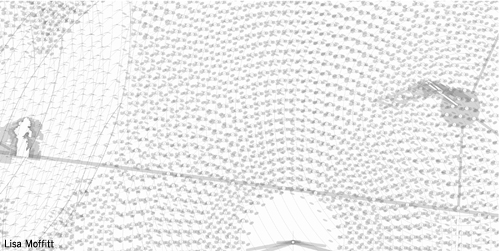Lisa Moffitt
Designed for Site #2 in Abu Dhabi, between Saadiyat Island and Yas Island.

Design Submission for the 2010 Land Art Generator Initiative Design Competition
Artist’s descriptive text:
Clouds, Lattices & Plumes capitalizes on the abundance of two natural resources available on the desert coastal site: sunlight and saltwater. The primary strategy for limiting the environmental footprint of the project is to treat these clean site resources (sun, clouds, water) as the dominant building materials of the project.
All elements on site follow radial geometries that overlap and converge, creating central nodes and perimeter moirés. A series of heliotropic, sun tracking mirrors, organized in radial arrays, focus light on solar power towers, generating roughly 10 megawatts of electricity for the local grid. The heliotropic mirrors, sun and cloud tracers, mechanically follow the trajectory of the sun, and are visible aerially from viewing platforms at site nodes.

A series of pools occur where the radial geometries overlap. Small-scale desalination pavilions at these pools generate clean water and highly saline water. Clean water is pumped to wading pools for recreational use on site. Saline water is pumped to salt ponds, where halophytic organisms thrive, creating shifting plume paintings in the landscape. Salt crystals collect and grow on sculptural towers set in the saline ponds.
Clean electricity is produced through Concentrating Solar Power Towers, which use heliostatic (sun-tracking) mirrors to focus light onto a thermal receiver placed on a power tower. This focused heat boils water and produces steam, which powers a standard turbine and generator in order to produce electricity that is fed into the local grid.

Four radial arrays of heliostat mirrors focus light on solar power towers. Each array consists of roughly 1500 3 meter diameter heliostats, totally 10,600 m2 of mirrored surface. These tracking mirrors focus light onto their respective 200 foot tall towers (wind tower components can be repurposed for this use), producing roughly 2.5 megawatts of electricity per solar array; approximate 10 megawatts of electricity is produced on site. The towers double as gnomens in a giant sundial, casting shifting shadows across the site. At the base of each tower, turbines and generators are housed in a lightweight production shed.
Plumes: Salt Ponds, Desalination Hubs & Wading Pools – Salt water is in abundance in Abu Dhabi; fresh water is not. Typically, desalination is an energy intensive process with high ecological tolls: the highly saline byproduct of production is recirculated at the point source, increasing the salinity of the local water source and negatively impacting the local marine ecology.

Clouds, Lattices and Plumes uses a low-energy, scalable method of water desalination to produce clean water for on-site recreation, while also retaining the saline water on site as striking visual elements in the landscape, rather than discharging it back at point source.
Using the Seawater Reverse Osmosis (SWRO) process , seawater is pumped to the desalination pavilion, filtered for large particles, pumped with a high pressure pump through membrane filters, and circulated into holding tanks. Each membrane filter (10cm diameter x 80 cm long) can process 1000 liters of water/day. 1000 liters of processing requires roughly 3.7 kwh of energy, provided through on-site electricity production.
Clean water is pumped into adjacent wading pools. Highly saline discharge is pumped into adjacent salt ponds. The highly saline water collects halophytic organisms that transform the saline water into pools of saturated, shifting plume paintings.
The pavilions are open-air in order to encourage visitor observation.
Lattices : Sculptural Salt Towers – Sodium chloride (NaCl) is in abundance in seawater. Due to it’s high ionic bonding and crystalline structure, salt collects and grows readily. A series of materials were tested for their ability to facilitate / encourage salt growth, and while the crystal structure varied by material, NaCl readily grew on any medium, forming cloud-like aggregations.
Steel structures with wool felt inlays, located in the salt ponds according to the radial geometries of the site, provide infrastructure to encourage salt crystal growth, a spectacle that shifts over time as salt collects and overtakes the salt towers.
Related Posts
1 Comment
Add comment Cancel reply
This site uses Akismet to reduce spam. Learn how your comment data is processed.

[…] growth, a spectacle that shifts over time as salt collects and overtakes the salt towers. Source: Land Art Generator Initiative Reageer […]